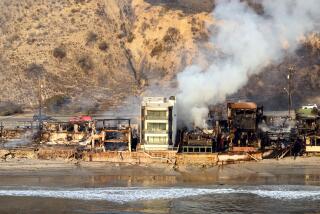Why Is It Taking So Long for Condo Earthquake Repairs?
- Share via
More than a year has passed since the Northridge earthquake, but repair work has barely started at the Sherman Villas condominium in Sherman Oaks.
Residents at the 72-unit complex moved out in June so that their condo association could do the necessary construction work. Now the condo owners are being told that contractors may not be finished with quake repairs until the second quarter of 1996.
“It’s a dicey situation,” conceded Harold Fremer, president of the Sherman Villas Homeowners Assn. and an architect who is working on about a dozen damaged condo projects in the San Fernando Valley.
What’s taken so long? The association is just now completing asbestos abatement work; next comes seismic retrofitting, then the replacement of nearly 75% of the walls, floors and ceilings at Sherman Villas. There has been lots of time spent trying to get together the funds for rebuilding from the association’s insurance company, the federal Small Business Administration and individual condo owners. It has also taken more time than originally expected to deal with the architect, engineer, contractors, etc.
Sherman Villas isn’t all that unique.
“So many of the projects we’re working on are still waiting for SBA loans or insurance money or dealing with contractors,” said Dan Shapiro, a Northridge resident and partner in the West Los Angeles-based law firm of Wolf, Rifkin & Shapiro. “There clearly are a lot of (condo) associations that are still dealing with insurance companies and haven’t started construction.”
Another problem faced by condo associations trying to rebuild is that between 51% and 100% of the owners in a particular complex need to agree on how much of a special assessment to impose on themselves to pay for damage not covered by insurance.
“This vote is difficult to obtain since the owners will not, normally . . . pass a special assessment against themselves until they know exactly what is being done with their money,” said Shapiro, whose firm represents about 1,000 homeowner associations in California. “Everybody is surprised that the rebuilding has taken this long.”
Bill Rake, president of the Greenspan Co., a public adjusting company with offices in Encino, blames insurance companies for the long delays in rebuilding earthquake-damaged condos. Rake’s company is representing about 150 associations in their efforts to get more money from their insurers. He complains that the insurance companies haven’t been organized and forthcoming enough.
“Many of the first adjusters sent out by insurance companies had no appreciation for the damage they were looking at. There was a lot of structural damage that wasn’t readily apparent.”
Even after more damage was uncovered, “the insurance companies became defensive of the original low damage estimates,” Rake said. “It’s been a bitter battle between insurance company experts versus association experts.”
Insurance companies maintain that they’ve made some mistakes but that they’ve done as good a job as could be expected under the circumstances. It hasn’t been easy, they say, to instantly beef up their local staffing and respond to an avalanche of claims.
Regardless of who gets blamed, up to 75% of the condo associations in the Valley have yet to begin making meaningful repairs, Rake said. The SBA also concedes that it has yet to complete processing on many of the 2,200 applications for aid submitted by homeowner associations after last year’s quake.
“Back in 1994, most of us assumed that by January, 1995, most of the damaged condo projects in the Valley would be put back together. This has not happened,” said James P. Lingl, a Camarillo-based condo attorney who represents more than 450 homeowner associations in Southern and Central California. “The process of coordinating engineers, building approvals, funding and rebuilding has been a much more heroic task than any of us expected.”
*
The projects that have managed to rebuild, Lingl said, are those that had minimal damage or where the owners had enough money to pay for a special assessment quickly out of their own pockets. “The difference is definitely money,” he said.
Two of Lingl’s clients that rebuilt quickly were the Springtime at Hunter’s Field condo complex in Simi Valley and Northridge Townhomes Estates in Northridge. At Springtime, Lingl said, the board was aggressive in passing a special assessment of $4,000 to $7,000 per unit, depending on the size of the unit. Residents paid the special assessment and are trying to get reimbursed by the SBA. Meanwhile, four red-tagged buildings are in the process of being reoccupied.
The situation is similar at Northridge Townhomes Estates--except that the residents have had to swallow a special assessment of about $11,000.
Many lenders who were expected to foreclose on cash-strapped condo owners just haven’t done so yet, Lingl said. The lenders don’t want to take over a condo unit and then have to pay an expensive special assessment.
Instead, many lenders are refusing to foreclose so that they can, for now, avoid having to contribute money to the associations. Lingl said this makes it hard for associations to raise funds needed for repairs for units where the owners may have walked away.
More to Read
Sign up for Essential California
The most important California stories and recommendations in your inbox every morning.
You may occasionally receive promotional content from the Los Angeles Times.






